According to the Center for American Women and Politics (CAWP), a record number of women are running for governor this year. But higher rates of candidacy among women doesn’t guarantee that women will meet or exceed the current (6) or record (9) number of women serving as governor. One key factor contributing to women candidates’ success will be money. That’s why we analyzed campaign finance data from the National Institute on Money in Politics (NIMP) with CAWP’s data on women gubernatorial candidates to determine how women are faring in their quests to finance their bids for governor in 2018.
Our analysis focuses on 8 states where gubernatorial primaries were held before July 1 and the incumbent did not seek reelection: Colorado, Georgia, Idaho, Maine, New Mexico, Ohio, Oklahoma, and South Dakota. Women made up only 24% of the primary candidates in these states (though women were 39% of Democratic candidates but only 11% of Republican candidates), and nearly one-third of the major party primaries across these states did not include a single female candidate (Republican primaries in CO, GA, NM, and OK, and the Democratic primary in OH). Whereas two male candidates sought the nomination for governor in uncontested primaries, no female candidate in this group had such a clear path to the nomination. Insufficient preprimary financial support might explain why more women did not compete; after all, putting together resources for a successful gubernatorial campaign is not easy.
We find that three of the five women who won major party nominations across these states outraised their opponents, and—in the case of Stacey Abrams (D-GA)—that the endorsement and financial support of EMILY’s List in Georgia’s all-female Democratic primary was likely a game-changer. While direct comparisons of men’s to women’s fundraising is limited due to the dearth of women candidates in this set of states, we find that Democratic women were more likely than men to lead in small contributions whereas the reverse was true for Republican candidates. In all five of the Democratic primaries featuring at least one female and one male candidate, the female candidates led in the proportion of total receipts made up of contributions $200 or less. In contrast, in two of the three Republican primaries featuring at least one female and one male candidate, the male candidates led in the proportion of total receipts made up of contributions of $200 or less. Across mixed-gender party primaries we analyzed, just one race had a candidate who was able to dramatically outraise their opponents because of personal wealth: Jared Polis (D) in Colorado.
The largest number of women candidates (4) to compete in a single primary across states in 2018 occurred in Maine, which has a public finance option for its gubernatorial candidates. However, Janet Mills, who secured the Democratic nomination, declined to participate in the public finance option and instead was privately funded. In sum, our analysis shows the ways that gender and party can interact to shape candidate entry and access to resources in gubernatorial primaries.
COLORADO
Despite Colorado’s status as 4th in the nation of 50 states for the presence of women state legislators, no women entered the Republican primary. The victor in the Democratic primary, Jared Polis, is a five-time congressman and a millionaire; if successful in the general election, he will be the nation’s first openly gay male governor. No female candidate was able to self-finance at this level.
Polis vastly outraised his opponents, including the two women running for the Democratic nomination. Polis contributed over $10 million to his own campaign, reducing his reliance on small contributors. Colorado has yet to elect a woman governor. Cary Kennedy, who placed second in the primary, served as State Treasurer.
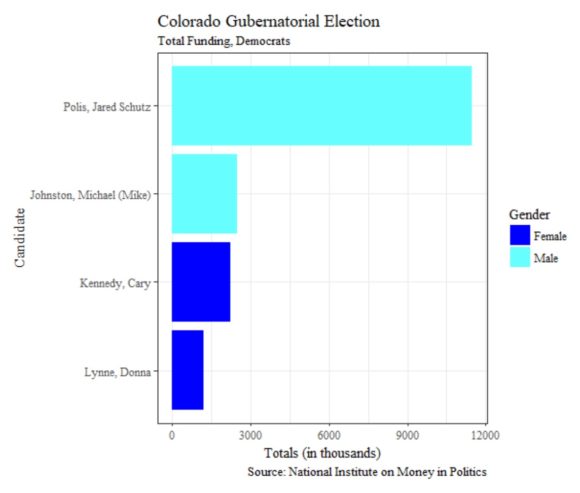
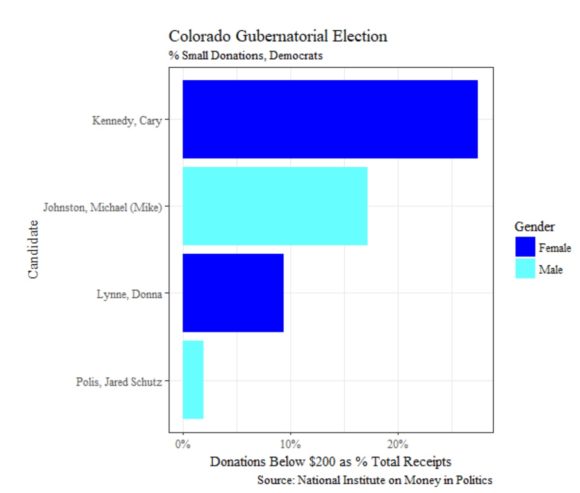
GEORGIA
One of the most closely watched races for governor is unfolding in Georgia where, for the first time in U.S. history, Democrats nominated a Black woman for governor: Stacey Abrams. Abrams secured the valuable endorsement of EMILY’s List and was able to outraise her sole opponent, Stacey Evans. Evans loaned herself $2 million in the race, but was still handily defeated by Abrams. Abrams’ fundraising success is notable because of the financial resource disadvantages typically facing candidates of color, and particularly women of color. Abrams had nearly twice as many contributors as Evans and raised more of her contributions from small donations (below $200). Meanwhile, no women competed in the crowded Republican primary.
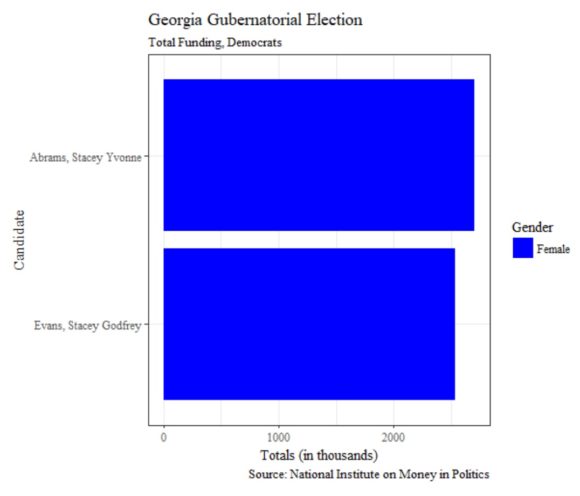
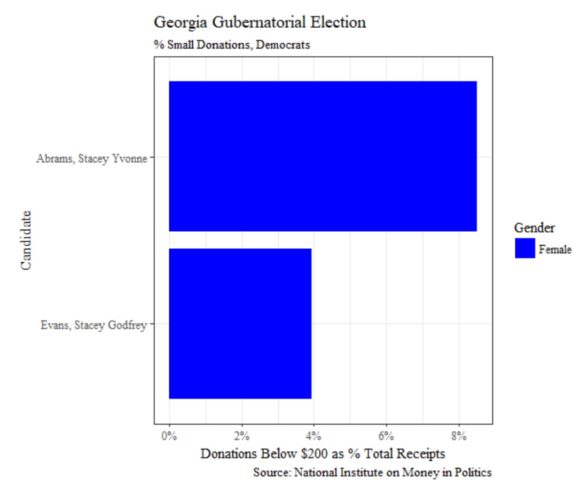
IDAHO
The Democratic party also nominated a woman for governor in Idaho—Paulette Jordan—although she will face a difficult general election campaign. Jordan, a state legislator and the first Native American woman to secure a major party nomination for governor in U.S. history, defeated two male opponents. Her opponent, A.J. Balukoff, who lost his bid for governor in 2014 and had previously served on a school board, outraised her.
In the Republican primary, only one female candidate, Lisa Marie, competed. Lacking funds or prior elective officeholding experience, she attracted less than 2% of the vote in what proved to be an expensive primary that pitted a former lieutenant governor against a member of Congress, among other male candidates.
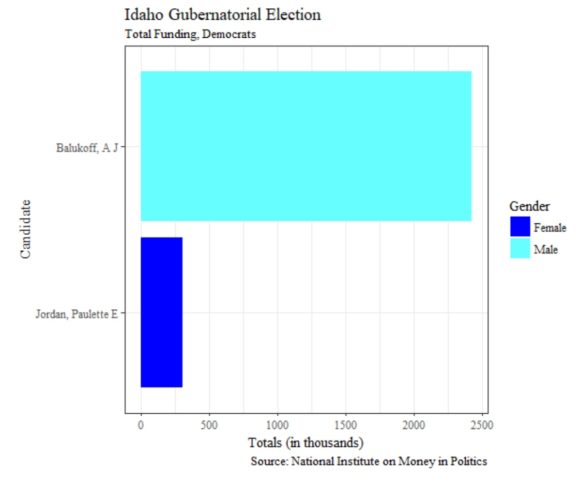
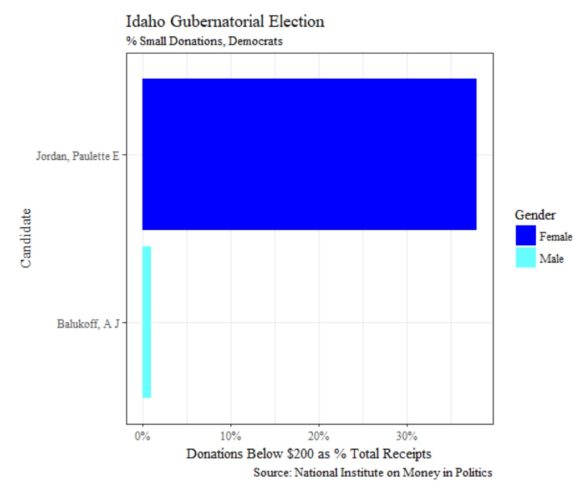
MAINE
Maine provides a public finance option for its gubernatorial candidates. Some proponents of expanding public funding for campaigns have argued that such reforms can benefit women candidates. However, in this election the female candidate who won a major party nomination was privately funded and therefore did not take any public funding.
The Democratic nominee, Janet Mills, was endorsed by EMILY’s List; she competed in a crowded field and did not raise the most money. Mills, the state Attorney General, defeated businessman Adam Cote, who led the field with respect to contributions and had never held elective office. Maine, which for the first time used ranked choice voting to select the Democratic nominee, narrowed the field down to Mills and Cote in tallying the final winner. Examining the first round of voting, Mills led Cote, and another female candidate, Betsy Sweet, who had not held office previously, placed third although she came in second with respect to fundraising. Sweet had participated in the state’s clean election fund, foregoing the possibility of raising private funds. (With ranked-choice voting, votes are reallocated to the voters’ second choice candidate if a candidate does not win the majority of votes in that round.)
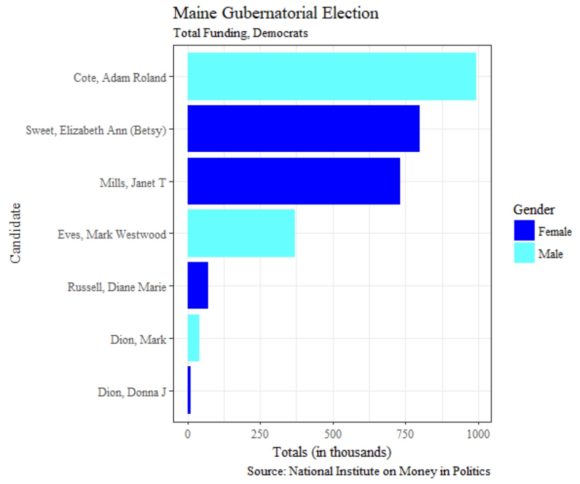
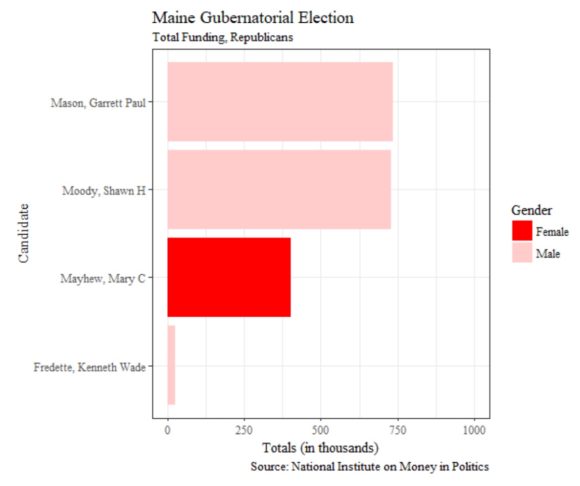
On the Republican side, the sole woman candidate, Mary Mayhew, a former state health commissioner, placed third in both fundraising and vote totals. Garrett Mason, a state senator, took part in the state’s public financing program and led slightly in contributions. But the winner of the primary was Shawn Moody, who has never held elective office. Republican Mary Mayhew and Democrat Janet Mills led their competitors with respect to the number of unique contributors.
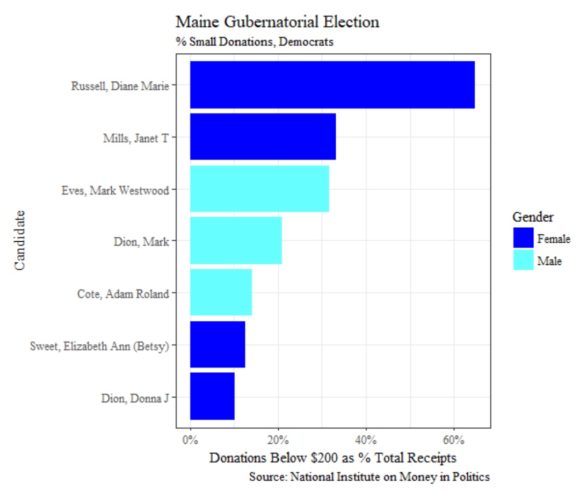
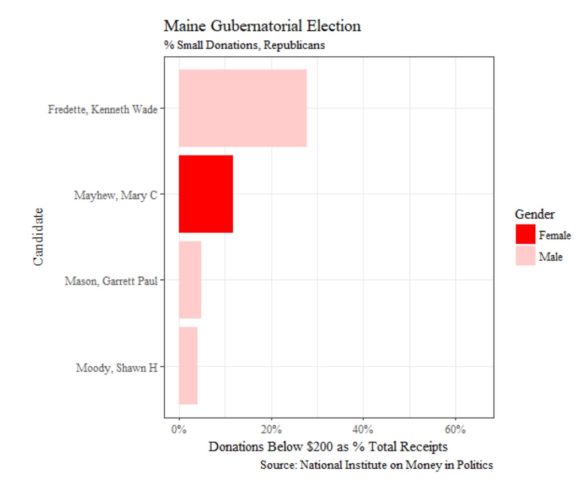
NEW MEXICO
New Mexico’s outgoing governor, Republican Susana Martinez, was the first Latina elected governor in the country. In 2018 it was the Democratic party’s turn to nominate a Latina, Congresswoman Michelle Lujan Grisham, for governor. Grisham, who was endorsed by EMILY’s List, defeated two male opponents in the primary. In the meantime, the Republican nominee, Congressman Steve Pearce, faced no primary competition.
Lujan Grisham led her competitors in fundraising. She also had many more unique contributors (over 29,000) than her opponents (fewer than 2,500).
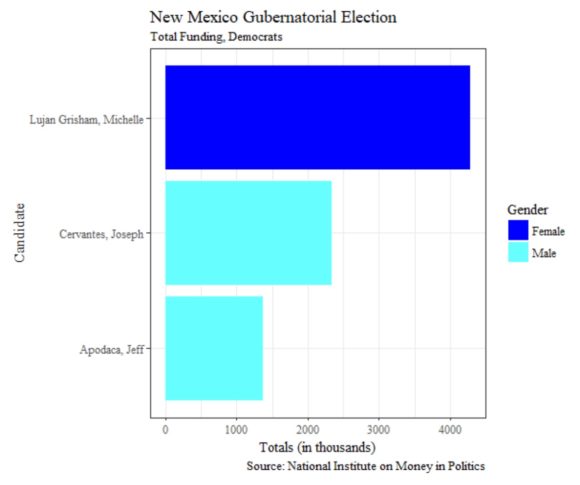
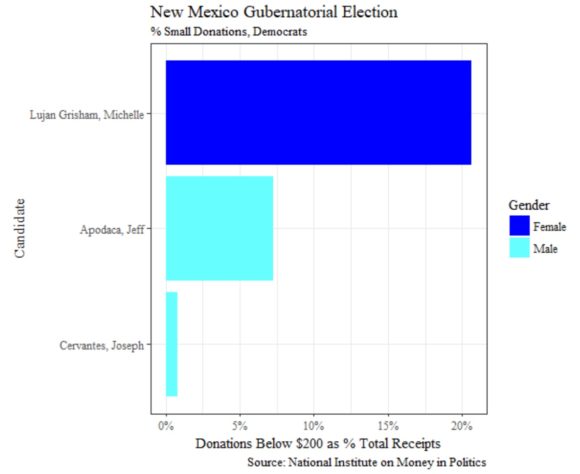
OHIO
Only one woman, a Republican, competed for governor in Ohio. Thus despite a record-setting year for Democratic women in other states, no women entered the crowded Democratic primary in Ohio.
Mary Taylor, the current Lieutenant Governor, lost to Mike DeWine, who has served in Ohio politics in many capacities including U.S. Senator and Lieutenant Governor. DeWine dramatically outraised Taylor, although Taylor managed to secure 40% of the primary vote. Whereas DeWine’s campaign attracted over 11,000 contributors, Taylor only had about 1,600. (Another Republican woman, Nancy Hollister, is the only woman ever to serve as governor in Ohio, although she only served on an interim basis.)
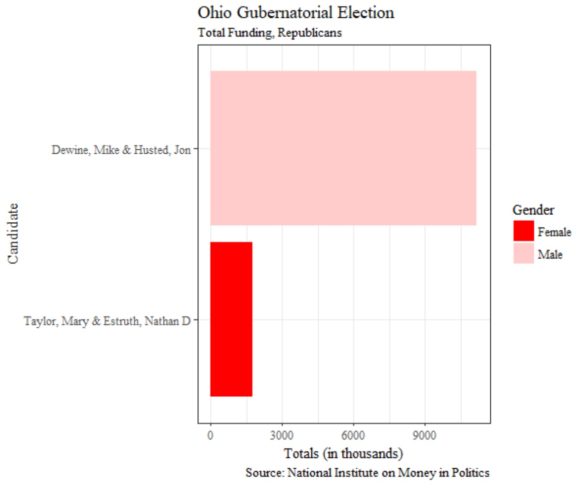
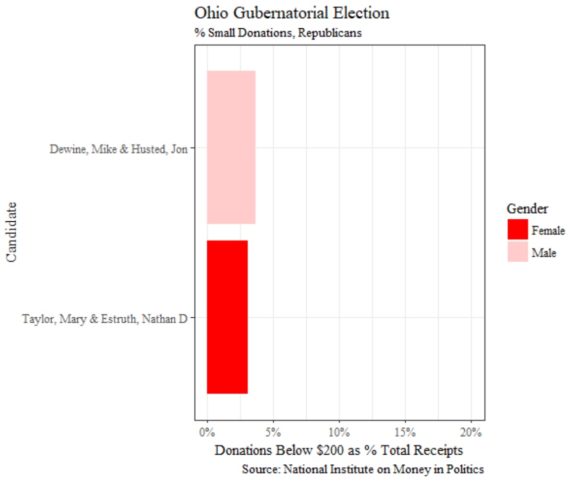
OKLAHOMA
In the Republican primary to nominate a replacement for outgoing Governor Mary Fallin (R), who is term-limited, no women entered the crowded open-seat race. Despite Oklahoma’s status as one of the only states to have a woman serving as governor today, Oklahoma ranks 48th of the 50 states for the presence of women state legislators.
The sole woman vying to be Oklahoma governor, Connie Johnson, lost her bid to become the Democratic nominee. Johnson, who is Black, is a former state legislator and her opponent, Drew Edmonson, was state Attorney General and a former state legislator. Edmonson dramatically outraised Johnson and won over 60% of the primary vote. Johnson, who is a former U.S. Senate nominee, had a higher proportion of small contributions than Edmonson.
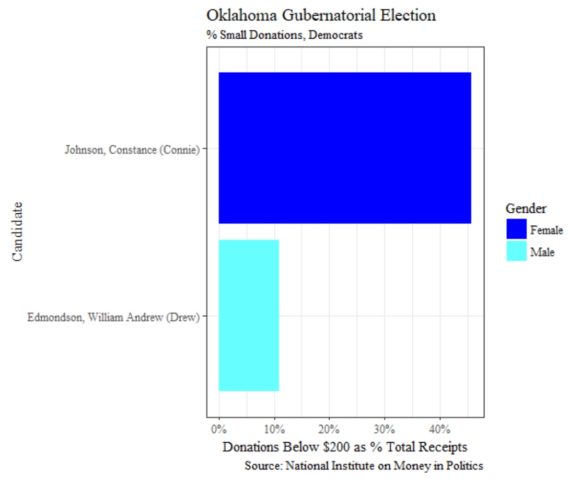
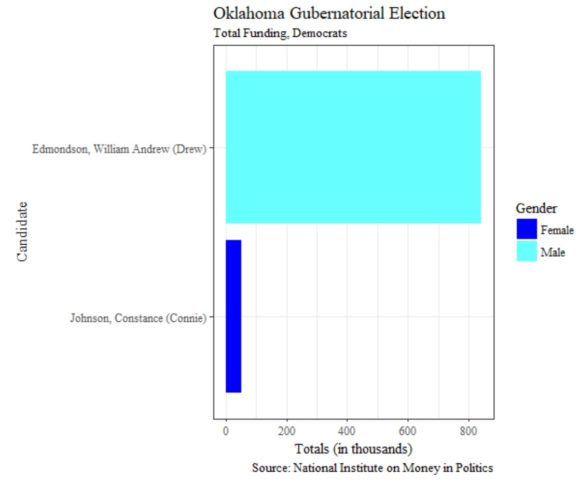
SOUTH DAKOTA
The only female Republican gubernatorial nominee to emerge from this group of states is Congresswoman Kristi Noem, who defeated her sole male opponent, Marty Jackley, the state Attorney General, in the primary 56% to 44%. Noem, as the at-large representative, had experience running statewide. She outraised Jackley and a larger proportion of her contributions came from small contributors. Jackley and Noem had approximately the same number of unique contributors. If elected, Noem will become South Dakota’s first woman governor.
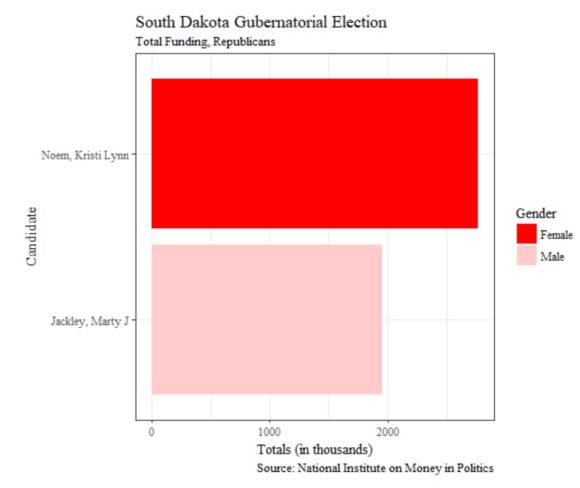
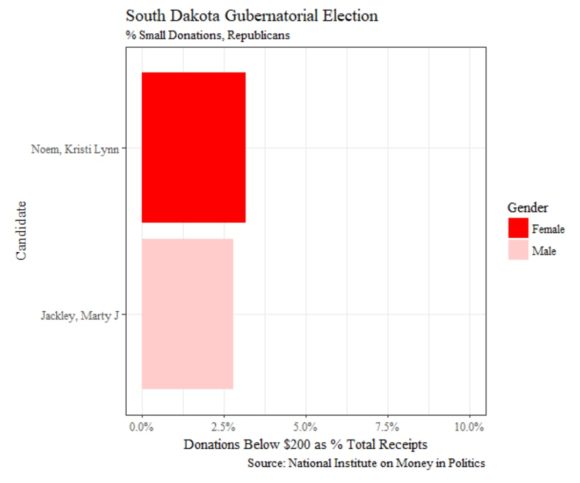
Methodological Note
We conducted our analysis state by state because we know from the Campaign Finance Institute (CFI) at NIMP that any comparison of campaign contributions across the 50 states must be viewed with caution because of state differences in campaign finance reporting requirements and contribution limits. Because dates are not required for reporting contributions in SD, we do not analyze SD contributions by date and may not be able to distinguish between primary and general election contributions. NIMP data are current as of 8/1/18. We exclude California from this analysis (although it is an open-seat race held before July 1) because its jungle primary means it is not directly comparable to the other states studied here; Nevada is also excluded because data were not complete.
Acknowledgments
The authors are grateful to NIMP Executive Director Edwin Bender and the staff at NIMP for their assistance. They also thank Brittany Smutek for research assistance, Chelsea Hill for the candidate information, and Edwin Bender, Kelly Dittmar, and Debbie Walsh for comments.


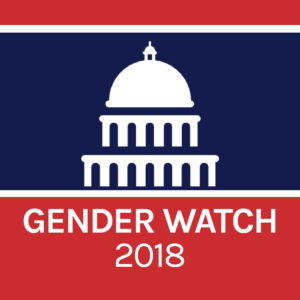 From March to December 2018, the
From March to December 2018, the 